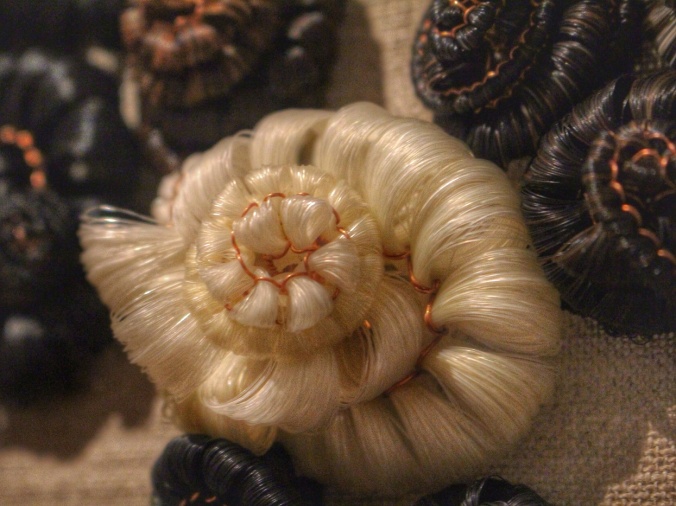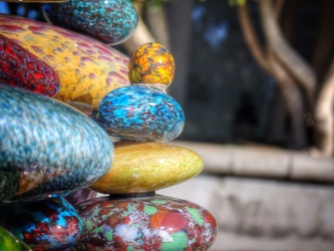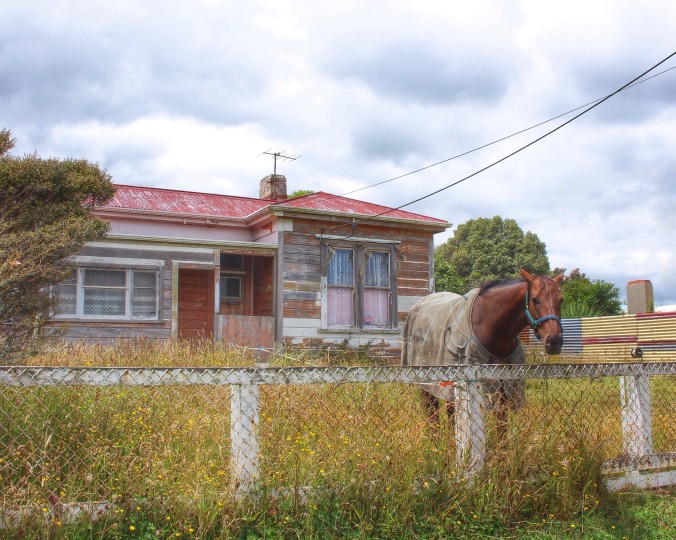
Detail; ‘The Horses Stayed Behind’, Cat Auburn, 2015. Sargent Gallery Te Whare o Rehau Whanganui. Image: Su Leslie, 2016
During World War I, the New Zealand government sent 10,000 horses overseas with its Expeditionary Force. These horses were not only ridden by mounted troops, but also used for artillery and transport everywhere NZ troops served; including Gallipoli, Palestine and the Western Front.
At the end of the war, only four horses returned to New Zealand (New Zealand History: NZ’s First World War horses).
Artist Cat Auburn took this astonishing and disturbing piece of information as inspiration and starting point for the work The Horses Stayed Behind which was recently exhibited at the Sargent Gallery in Whanganui.

‘The Horses Stayed Behind’, Cat Auburn, 2015. Sargent Gallery Te Whare o Rehau Whanganui. Image: Su Leslie, 2016
The work consists of 500 horsehair rosettes positioned across five panels. Each one is made of hair from a single horse.
Sarah McClintock, from the gallery wrote of the work:
For The Horses Stayed Behind Auburn asked horse owners from across the country to donate a small clipping of full length hair from their horse or pony’s tail which she then made into rosettes, flowers made in the style of Victorian hair wreaths.

Detail: ‘The Horses Stayed Behind’, Cat Auburn, 2015. Sargent Gallery Te Whare o Rehau Whanganui. Image: Su Leslie, 2016
What struck me about this work — apart from the beauty and craftswomanship of each rosette — is that it is the only truly feminine war memorial I have ever seen.
The rosettes themselves are an example of a very feminine art-form. A lock cut from a loved one’s hair is widely seen as having sentimental value, and the making of jewellery and other objects — including mourning wreaths — has a long history (Wikipedia: Hair jewellery). In Victorian times, mourning wreaths were a form of family story-telling as well as providing a focus for grief.
In contrast to the more usual bronze or stone war memorials, which tend to be hard, cold and upright, The Horses Stayed Behind is soft and delicate — and horizontal. There is no sense of a monument towering over visitors; instead the panels are set at eye level and invite close inspection.

Detail; ‘The Horses Stayed Behind’, Cat Auburn, 2015. Sargent Gallery Te Whare o Rehau Whanganui. Image: Su Leslie, 2016
McClintock also wrote of the wider impact of the work:
Each donation of horse tail came to Auburn with a story. Some with small notes of support, others with cherished photographs and heartrending tales of riders and horses that have passed away. The cathartic nature of this project has gone well beyond the memorialisation of the World War One horses and has become an active way for members of the riding community to pay tribute to their colleagues, horses, and ponies. This type of mourning, a multi-sensory way of expressing grief, is a central part of The Horses Stayed Behind. Long forgotten events and memories of loved ones can be triggered by a smell, taste, or sound. The final form the rosettes take across the canvases not only resembles a heartbeat but also an isolated audio track. The horses and riders from the past and present join together in this work with a voice that speaks of collective mourning and loss.
Such a collaborative and multi-layered way of creating a memorial seems to me a very feminine approach, weaving many levels of meaning and remembrance — and the experiences of a diverse group of people — into the fabric of the work.
You can hear Cat Auburn talking about the work here:
https://soundcloud.com/sarjeantpodcast/episode-one-the-horses-stayed-behind




















